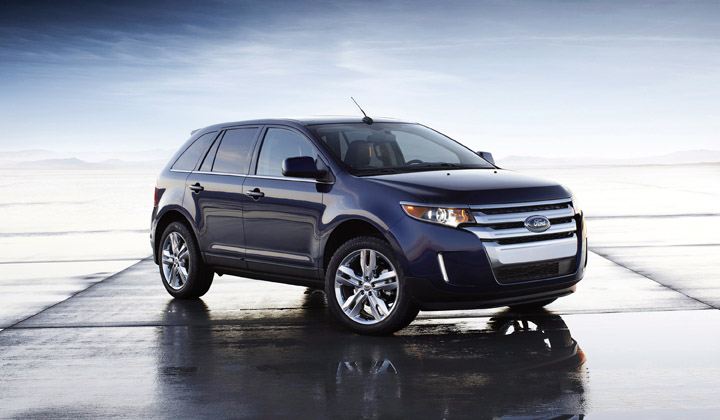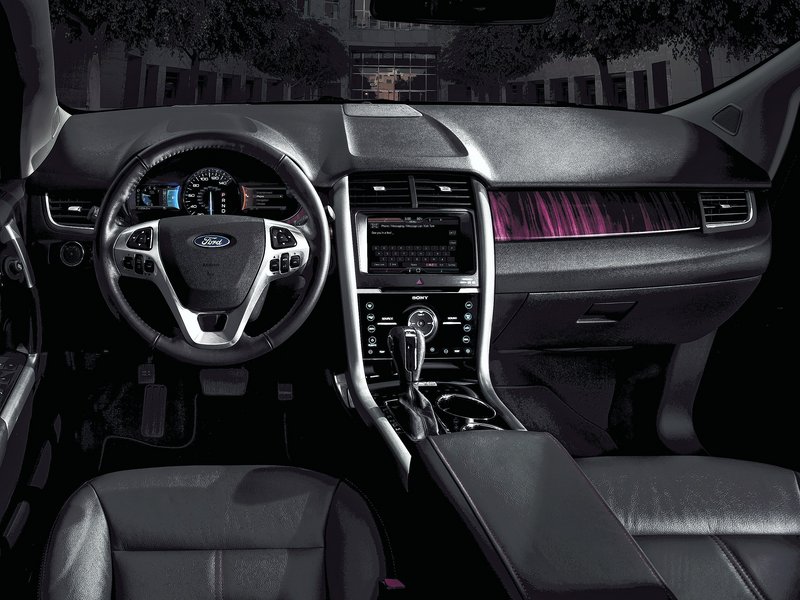Ever since its introduction as a 2007 model, Ford’s Edge has been a sales leader among midsize five-passenger crossovers. But with new and improved competition from vehicles such as Toyota’s Venza and the redesigned Jeep Grand Cherokee, Ford needed to do something to keep its edge.
It did a whole lot of something for the 2011 model year. Ford gave the Edge a full nose job (new hood, fenders, grille and headlights), upgraded its engine and completely revamped the cockpit. It also gave it new taillights.
I recently tested a 2011 Edge SEL AWD, which is virtually identical to the 2012 model. The one notable exception for 2012 is that an economical four-cylinder, turbocharged engine is now an option for three of the four Edge models.
This is the same high-tech, 2.0-liter “EcoBoost” engine Ford offers on its other midsize crossover, the Explorer. It can deliver up to 240 horsepower and 270 pounds-feet of torque while delivering an EPA-rated 21 city/30 highway miles per gallon.
The standard Edge engine is either a 3.5- or 3.7-liter V6, depending on trim level. The Edge Sport gets the latter, which is the same engine found in Ford’s sporty V6-powered Mustangs. It generates 305 horsepower and 280 pounds-feet of torque while earning an EPA-rated 17 city/23 highway mpg on the Sport AWD.
The Edge SE, SEL and Limited models get better mileage thanks to their smaller but otherwise similar 3.5-liter V6 engines.
Ford boosted the engine’s power and fuel efficiency during its 2011 Edge upgrade by endowing it with a sophisticated new valve system. As a result, the 3.5-liter engine now produces 285 horsepower and 253 pounds-feet of torque compared with 265 and 250, respectively, for the 2010 version.
Fuel economy also is up. The EPA ratings say that 2011 and 2012 Edge SE, SEL and Limited AWD models can travel one city or two highway miles farther on a gallon of gas than 2010 Edge 3.5-liter models.
I was impressed with the Edge SEL test car’s power and fuel economy during a trip that spanned eight hours of mostly interstate driving. The Edge achieved around 24 mpg during the journey at speeds averaging 70-75 mph.
Mileage dropped noticeably when the Edge meandered mainly around town in stop-and-go traffic. Nevertheless, its nearly 22 mpg average seemed good given the test car’s full-time all-wheel drive, size (nearly 4,300-pound curb weight) and power.
As the kind of driver who gets criticized for making test cars feel like rollercoasters, I’d love to see how much more oomph the 3.7-liter engine provides. And I’m anxious to see for myself if Ford’s highly touted EcoBoost four-cylinder can deliver the kind of mileage it promises without feeling anemic.
But having experienced only the 3.5-liter Edge wasn’t frustrating because it delivers a great balance of power and fuel economy for a midsize crossover.
Like everyone else, of course I’d like to go as far as possible on a $4 gallon of gas. But not at the expense of driving a vehicle that moves like a turtle with tendonitis in all four legs.
While not quite hare-like in quickness, the Edge moves authoritatively whenever its throttle is nudged. The engine delivered rewarding response during stoplight launches, highway merges and interstate passes. It cruised effortlessly at 75 mph and made a few steep grades in Vermont’s Green Mountains seem flatter than they were.
It’s also capable of towing up to 3,500 pounds, according to Ford.
I never noticed the six-speed automatic transmission with which all Edges are equipped or the AWD that is available on six-cylinder models. That’s a good thing; you want those components to be unobtrusive in family vehicles such as the Edge.
Families that need a midsize crossover with seven-passenger seating will have to look at the excellent new Explorer (reviewed here two weeks ago) if they want a Ford. But those who need no more than five seats should find the Edge very accommodating.
Front-row passengers will appreciate the greatly upgraded cockpit. With the 2011 makeover, it has evolved from cheap-looking to upscale. I still find the MyFord Touch system’s lack of real knobs and switches for radio, climate and other controls inconvenient. But the Edge’s voice recognition and responsiveness seemed much better than the one I tested on the Explorer.
Behind the cockpit, the Edge’s second-row seats feature plenty of leg- and headroom. The seat is a bit narrow for three adults, but two grownups and a kid should be pretty comfortable back there.
The rear seatbacks are split-folding on all Edge trims and provide nearly 70 cubic feet of cargo space when flattened. That’s near best-in-class. The Edge doesn’t rank as highly for cargo space behind the second row, but it was nevertheless roomy enough for a junior hockey goalie’s gear bag, his hockey stick and two overnight bags.
With that gear and three passengers onboard, the Edge provided comfortable cruising. For some reason, it feels a little more carlike than the Explorer. Overall handling is about average for modern, midsize crossovers, with nothing to either brag or complain about.
In other words, Ford has done a good job finding the right balance of handling and comfort, power and fuel economy in the Edge. With a starting price of around $28,000 for a reasonably well-equipped SE, it should be considered by anyone shopping for a five-passenger, midsize crossover.
Scott Wasser is a freelance auto writer who can be reached at carguysw@aol.com
Send questions/comments to the editors.




Success. Please wait for the page to reload. If the page does not reload within 5 seconds, please refresh the page.
Enter your email and password to access comments.
Hi, to comment on stories you must . This profile is in addition to your subscription and website login.
Already have a commenting profile? .
Invalid username/password.
Please check your email to confirm and complete your registration.
Only subscribers are eligible to post comments. Please subscribe or login first for digital access. Here’s why.
Use the form below to reset your password. When you've submitted your account email, we will send an email with a reset code.